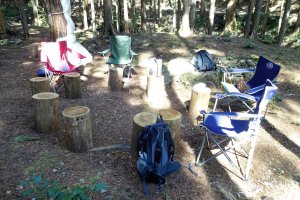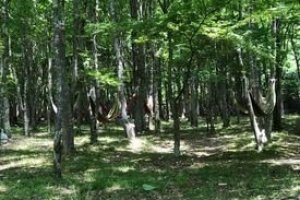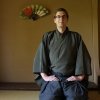Japan is a mecca for forest lovers. In fact, the country’s best kept secret is Japan’s forests. On the International Day of the Forest on March 21 we celebrate our tree friends and all other beings of the woods, and what better way doing this than going for a slow walk in a nearby forest.
About 70% of Japan is covered by forest and there are a great number of National Parks and Recreational Forest where access to forest is convenient and where forest experiences are facilitated.
One such forest experience is Forest Therapy, which has gained popularity internationally in recent years as a recognized health management practice.
The roots of Forest Therapy are in the Japan of the 1980s. It all started with shinrin-yoku, or “forest bathing”, a word that is now part of the vocabulary of all trendy health bloggers and wellness gurus around the world.
Now, 40 years later, there are 65 Forest Therapy centers in Japan in locations ranging from Hokkaido to Okinawa. Each center has a Forest Therapy base and trails as well as certified Forest Therapy guides.
There are not many English-speaking trained Forest Therapy guides in Japan yet but their number is increasing. In addition, there are some Japanese guides who were trained by international Forest Therapy associations but they operate in Japan and usually speak English very well.
Why not join a Forest Therapy walk the next time you come to Japan? Whether you are a beginner or already a seasoned practitioner of Forest Bathing, it will be a wonderful experience in one of Japan’s great forests.

Slower than Hiking
When we go hiking or trekking, we walk through forests and mountains but often there is little time to linger and appreciate nature. We are on a schedule and we want to get from A to B. Often the only time we stop is when we take a snapshot.
Our walk is often rather speedy and often we talk to our fellow walkers. We aim for good health by getting some mileage under our belt and even track our achievements with an app on our smartphone or on another electronic device. We don’t pay much attention to the forest that we are passing through because often we talk to our fellow walkers.
With Forest Therapy, the key is to go slow, very slow that is, and to immerse yourself with all your senses. Imagine nature as being a big bathtub where you soak in its colors, scents and sounds, all while being fully clothed, and you get the idea.

Walk with a Forest Therapy guide
Forest Therapy walks are typically done with a guide. This is someone who has trained to be a Forest Therapy Guide and who is licensed.
Forest Therapy guides know the area that they are taking people to. They know the trails, the specifics of the landscape and the local flora and fauna. Yet, they are neither Tourist Guides nor Nature Guides. Learning about the local sights or getting a lesson in how to identify trees, flowers or birds is not the objective of a Forest Therapy walk.
What the Forest Therapy guides are there for is to stimulate your perception and lead you to engage all your senses. Many of us are a little rusty in really using our senses. The guide will prompt you and encourage you by issuing ‘invitations’ to connect with nature by using one of your senses or all of them.

Out of the head and into the body
Our senses are the interface between the outside world and our inside world. They let us experience our surroundings and connect with what is around us. The five senses are functions of our body that we take for granted but we don’t really take advantage of this gift anymore.
When do we really see, hear, smell, taste and feel things around us, much less nature where we spend so little time these days.
Many of us live in their heads and through their mobile devices. We think about the world rather than actually sense it with our body. Virtual experiences replace the real thing.

Let’s take an imaginary walk into the forest:
Do you notice the faint sent of the shrubs next to the trail?
How about listening to the murmur of the little stream that runs by the trail?
Does the breeze of wind gently blowing through the valley cool your skin?
Do you notice the different shades of green around you and the different shapes of trees and leaves?

Invitations and sharing
For the duration of a Forest Therapy walk of 2 to 3 hours, there is a series of these invitations that are focused on stimulating and using your senses.
After each experience, the group comes together and participants are encouraged to share some impressions.
The group, together with the guide, might be moving from one place in the forest to another, or place themselves in just one location and from there take short walks out and back.
At some point during the Forest Therapy session, participants will share a cup of tea and some snacks, or even a bento box.

Healing fragrance from the forest
In recent years there has been an increasing interest in the ‘life of trees’ and the relationships between trees, and between trees and other inhabitants of the forest. More and more insights come to light and they tell us that the forests are webs of living beings other than humans who interact with each other, defend themselves and help each other.
While being in the forest, you are breathing in wood essential oils from the trees around you. These essential oils are called phytoncides and they are defined as “anti-microbial volatile organic compounds” that are emitted by trees to protect themselves against insects.
When we walk through a forest and breathe in forest air, we also breathe in these phytoncides. Our bodies react to these “chemicals” by producing more white blood cells, also called “natural killer cells”, or short NK. Thanks to the activity of these cells in our bodies we are protected against tumors and virus infections.

Health benefits
Forest Therapy is not just a re-discovery of the old-age wisdom that being in nature and walking in forests is good for the body and mind, but there is actually a wealth of scientific data that proves it.
These data were gathered from a series of experiments and they show that a slow walk in the bush will boost your immune system, reduces stress and encourages healing. There is a wealth of information about the health benefits of Forest Therapy available on the Internet.
For example, a Forest Therapy walk helps to increase the parasympathetic nerve activity and decrease the sympathetic nerve activity. The sympathetic nervous system helps people cope with stressful situations. Its activation results in a rise in blood pressure, an accelerated heart rate and other body actions that prepare you for a "fight or flight' response in a dangerous situation.
It is interesting that many of our daily life situations in the 21st century resemble this scenario. This is why many people are constantly in a "flight or fight" mode. They can never relax, calm down and take things easy. For this to happen, you need to activate the parasympathetic nervous system. And a Forest Therapy walk does exactly that!


Forest Therapy plus alpha
While the health benefits are already convincing enough, Forest Therapy should be fun and relaxing. This is why Forest Therapy bases and guides in Japan continuously expand their repertoire of Forest Therapy experiences to find something for everyone. All happens in the forest of course! Here are some of the options:
- There are walks for solo people and walks for families with children.
- There are walks that incorporate yoga or meditation.
- Some other walks include handicraft experiences, such as natural dying or making a bracelet with wooden beads.
- There is even a “book café” in the forest. What better way to relax after a forest walk than having a cup of coffee and flicking through some books that feature nature themes.


Forest Therapy goes international
In the last five years Forest Therapy has gained in popularity outside of Japan too. There are already many reports in newspapers, magazines, on TV, on online channels and portals about the health benefits of Forest Therapy.
In addition to the Forest Therapy Society in Japan, there are now a number of organizations around the world that have set up their own Forest Therapy training and certification schemes. While the overall idea is the same and the health benefits are the same, the approach and method of how to conduct a Forest Therapy walk differ.
Forest Therapy organizations in each region of the world, be it North America or South America, Europe, Asia or Australia, for example, have incorporated elements that have roots in their region. A quick internet research will let you know whether there are any Forest Therapy clubs, groups or events available near you.
Why not try out a Forest Therapy walk closer to home first and then join one on your holiday in Japan, the birthplace of Forest Bathing!


































